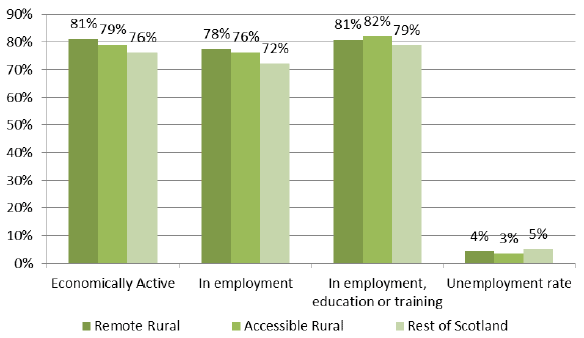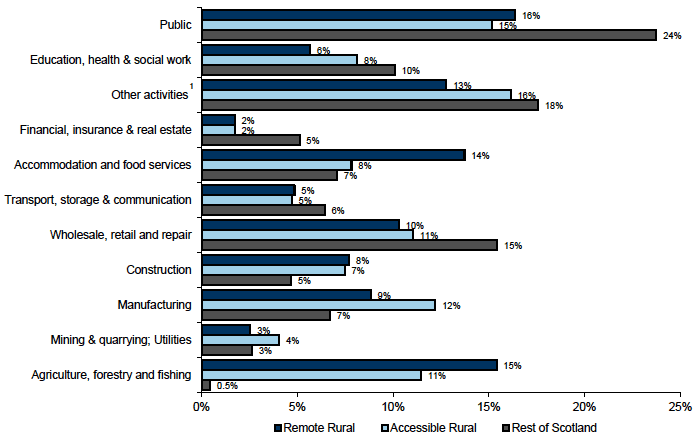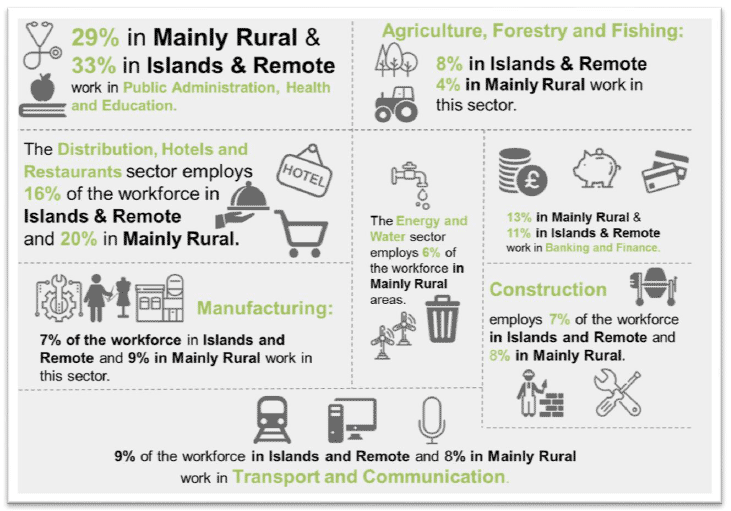Understanding the Scottish rural economy: research paper
This report outlines the Scottish Government's understanding of the Scottish rural economy and presents economic and social data.
Employment and Unemployment in Rural Scotland
Employment and unemployment are key drivers of public policy and of the Scottish Rural economy. Employment is measured through a range of household surveys including the Scottish Household Survey, and through the Labour Force Survey. There are structural issues which may affect employment and unemployment in rural Scotland, people may choose to move from rural to urban areas in search of employment reflecting the greater job opportunities. This combined with age structure issues can give rural and especially Remote Rural particular demographic challenges. Bearing this in mind however, on average, unemployment is lower in both Accessible Rural and Remote Rural Scotland, as shown in chart 9 below:
Chart 9: Unemployment and Employment Rates in Remote Rural, Accessible Rural and Urban Scotland compared, 2016

Source: Annual Population Survey in Scotland, Jan-Dec 2016; Using the Scottish Government Urban Rural Classification 2013-2014
The chart above shows four different ways of understanding employment and unemployment. The first set of columns shows people employed or looking for work. The second set shows those employed as a percentage of the total working age population. The third shows those in employment, education and training. The final set shows the unemployment rates. The trend is consistent for each set, showing that unemployment is higher in Urban Scotland than in either of the rural classifications, at around 6% for Urban Scotland and 4% for both remote and Accessible Rural Scotland. However looking across the piece it is possible to discern that overall in employment terms Remote Rural Scotland is slightly better than Accessible Rural, and Accessible Rural is slightly better than urban Scotland. There may be issues around job quality or preferences but it is not possible to discern them in the data we have. This is shown in the economic activity rate, which is highest in Remote Rural Scotland, the overall employment rate, which again is highest in Remote Rural Scotland, and the employment, education or training class, which again is highest in Remote Rural Scotland.
There are more recent figures if we use the RESAS defined Rural local authorities. This approach specifically identifies there are only two which have unemployment levels higher than the Scottish average of 4.8% (2016). These two areas are East Ayrshire and South Ayrshire, with East Ayrshire far above the national average. At the other end of the scale, both the Orkney Islands and Shetland Islands have very low rates and levels of unemployment, as does Aberdeenshire. It is not possible to say whether this represents a better performing labour market in Remote Rural areas, or whether there is simply the out-migration from those areas of those who would otherwise likely be unemployed. In practice, it could be an element of both, though it would take longitudinal research to establish the relative importance of each aspect. The table is below:
Table 3: Unemployment rates and levels in Rural local authorities
| Local authority | Unemployment rate 2016 | Unemployment level 2016 |
|---|---|---|
| Aberdeenshire | 3.8% | 5,300 |
| Angus | 4.1% | 2,500 |
| Argyll and Bute | 3.7% | 1,600 |
| Clackmannanshire | 5.6% | 1,300 |
| Dumfries and Galloway | 4.1% | 3,000 |
| East Ayrshire | 6.5% | 3,500 |
| East Lothian | 4.4% | 2,200 |
| Highland | 3.7% | 4,500 |
| Moray | 4.1% | 2,000 |
| Na h-Eileanan Siar | 3.9% | 500 |
| Orkney Islands | 2.6% | 300 |
| Perth and Kinross | 3.4% | 2,600 |
| Scottish Borders | 4.3% | 2,400 |
| Shetland Islands | 2.8% | 400 |
| South Ayrshire | 5.0% | 2,600 |
Source: Local authority web tables from the Regional Employment Patterns in Scotland: Statistics from the Annual Population Survey publication using RESAS Classification 2018.
Employment by sector, excluding small businesses and self-employment
Employment data shows a different picture to that from the economic data, reflecting the better definition found at postcode level. The Scottish Household Survey offers the opportunity to go down to a lower level than the economic survey data used above, and also to make use of the Scottish Government's Urban - Rural classification, which is much more accurate to the rurality of the area, as it is based on postcode areas which are much smaller and less heterogeneous than local authorities. With this data we can look at the distinction between Accessible Rural Scotland (areas within a 30 minute drive-time of population centres; and Remote Rural Scotland, which are more inaccessible, see table 1). In this section we will look at employment data; and then a range of accessibility and household data to show the constraints on households living in Rural Scotland. However, it needs to be noted here that the data does not cover very small businesses without VAT or PAYE schemes ( i.e. self-employed and those with low turnover and without employees) and some non-profit making organisations. Micro-businesses that are highly common in rural Scotland are partly not represented in the data.
As can be seen in the chart below which identifies employment by location of the workplace there are strong distinctions between Remote Rural, Accessible Rural and urban Scotland.
Chart 10: Employment by industry sectors and in the public sector by geographic area, 2016 [6] , excluding self-employment and small businesses

Source: Inter-Departmental Business Register, as at March 2016 (Using Scottish Government Urban Rural Classification 2013-2014)
This figure shows the distribution of employment across sectors across the threefold SG Urban/Rural classification that is based on postcodes and thus more detailed. The top line of each set is the figure for Remote Rural Scotland, the middle line Accessible Rural Scotland and the third line is the rest of Scotland.
In Remote Rural areas, 'Agriculture, forestry and fishing' is the largest source of private sector jobs (15%) followed by 'Accommodation and food services' (14%) and then 'Other activities' (13%). In Accessible Rural areas, 'Other activities' (16%), 'Manufacturing' (12%) 'Agriculture, forestry and fishing' (11%) and 'Wholesale, retail and repair' (11%) are the largest sources of private sector jobs. 'Agriculture, forestry and fishing' is a sector that shows the greatest difference across Scotland, accounting for 15% of workers in Remote Rural areas compared to 11% in Accessible Rural areas and 0.5% in the rest of Scotland. Conversely, other sectors such as 'Wholesale, retail and repair' and 'Financial, insurance & real estate' are a larger source of jobs in the rest of Scotland than in rural areas. Given the overall higher employment rates in Remote Rural Scotland, it may be that agriculture, forestry and fishing is helping to support the higher employment rate, but in low paying activities.
One area that does stand out in the household level data is the relatively lower dependence of Accessible Rural and Remote Rural areas on public sector employment at only 15% and 16% of jobs in those areas as compared with 24% for the rest of Scotland. Given that the overall GVA contribution of the public sector is similar for both rural and urban Scotland this may reflect relatively higher non-employment related costs in rural area.
The data discussed above is aggregated at data zone level and therefore allows us a very detailed distinction in terms of rurality. However, self-employment and very small businesses are not included in the dataset. The Annual Population Survey includes these businesses, but data is aggregated at the local authority level, which is why for the following section, the analysis follows the RESAS Classification.This also allows us to compare GVA and employment, as we need to take both into account if we want to understand what the rural economy looks like.
When comparing GVA and employment, we need to be aware of the different definitions used in the datasets as different coding of industry sectors was applied. Thus, rural Scotland is defined as Mainly Rural and Islands and Remote following the RESAS Classification.
Employment by Sector, including small businesses and self-employment
Figure 3 and table 4 help us to understand variations in employment rates between Mainly Rural, Islands and Remote and the Rest of Scotland. The top line of each set is the figure for Islands and Remote, the middle line Mainly Rural Scotland and the third line is the rest of Scotland. Because the data presented below is only available at the local authority level and codes sectors differently, we cannot fully compare it with the data discussed above and shown in chart 10.
However, we can see that when self-employment and very small businesses are also included, the patterns change quite substantially. In every sector, we see some variation of employment numbers between rural areas (see table 4), but overall urban and rural economies look quite similar. 'Public Administration, education and health' (figure 3) - comparable to 'Public' and 'Education, health and social work' (chart 10) - remain the largest employer for all areas in Scotland, the importance of 'Agriculture, Fishing and Forestry' seems to decline when self-employment and non- VAT registered businesses are included. In Mainly Rural areas the sector only employs 4.4% of the workforce. It is relatively more important in the Islands and Remote areas (7.7%). This makes the sector the smallest one in terms of employment in Mainly Rural and fifth in Islands and Remote areas.
Figure 3: Rural and urban employment rates, arranged by relative size in Scottish economy - including self-employment and small businesses

Source: Regional Employment Patterns in Scotland: Statistics from the Annual Population Survey, 2017 (Using Scottish Government RESAS Classification 2018)
We can see however that for the rural economy overall the sectors 'Energy & Water' and 'Agriculture, Fishing & Forestry' are more important in terms of employment numbers compared to the rest of Scotland. Even though the share of the workforce employed in Public Administration, education and health is smaller in Mainly Rural areas compared to the rest of Scotland, it still remains the largest employer overall. About 50% of the workforce is employed in 'Public administration, health and education' and 'Distribution, hotels and restaurants'. As expected, 'Banking and finance' is relatively less important in rural areas.
While 'Manufacturing and Construction' is noticeably more relevant to Mainly Rural areas and employs 9% of the workforce, it employs 6.5% of the workforce in the Islands and Remote parts of Scotland. 'Construction' employs between 7 to 8% of the workforce in urban and rural Scotland. 'Transport and communication' seems more significant for the Islands and Remote areas with 9% employed in this sector in contrast to only 6% in Mainly Rural areas. The sample size for the sectors 'Energy and Water' and 'Other Services' is too small for Islands and Remote areas, which is why it cannot be included.
Table 4 Rural and urban employment by Sector 2016, (aged 16+) by Industrial Group and Area
| Area | Agriculture, forestry and fishing | Energy and water | Manufacturing | Construction | Distribution, hotels and restaurants | Transport and communication | Banking and finance | Public admin, education and health | Other services | Total |
|---|---|---|---|---|---|---|---|---|---|---|
| Scotland | 1.8% | 3.4% | 7.7% | 7.1% | 18.7% | 7.7% | 16.0% | 30.9% | 6.1% | 2,581,000 |
| Larger Cities | * | 2.9% | 5.5% | 5.9% | 17.0% | 9.6% | 20.0% | 31.6% | * | 718,100 |
| Urban with Substantial Rural | 0.8% | 2.2% | 8.7% | 7.4% | 19.2% | 7.8% | 16.0% | 31.9% | 5.6% | 1,061,400 |
| Mainly Rural | 4.4% | 5.6% | 8.7% | 7.7% | 19.9% | 5.7% | 12.7% | 28.6% | 6.0% | 721,800 |
| Islands and Remote | 7.7% | * | 6.5% | 7.4% | 16.3% | 8.9% | 11.0% | 32.9% | * | 79,700 |
1. Figures may not round to 100% due to missing values
2. Level rounded to the nearest 100
3. Some values are suppressed using * where the data is limited by small sample sizes
Source: ONS, Annual Population Survey (2016) (Using Scottish Government RESAS Classification 2018).
Patterns of Employment
Going beyond employment numbers, we can also see that the pattern of people's daily employment in Remote Rural Scotland is not the same as in urban Scotland. Self-employment is more than twice as high - 22% of people are self-employed as compared with 10% for the rest of Scotland. People in Remote rural Scotland are also more likely to work a second job - 8% for Remote Rural vs. 3% for the rest of Scotland; and also more likely to work from home (24% for Remote Rural Scotland vs. 9% for the Rest of Scotland). All is shown in the table below:
Table 5: Patterns of work by geographic area, 2016, population aged 16+
| Local authority | Remote Rural | Accessible Rural | Rest of Scotland |
|---|---|---|---|
| Percentage of employed males who are: | |||
| Self-employed | 32% | 22% | 14% |
| Working part time in main job | 14% | 12% | 13% |
| With a second job | 6% | 4% | 2% |
| Homeworkers 1 | 32% | 21% | 11% |
| Percentage of employed females who are: | |||
| Self-employed | 17% | 15% | 8% |
| Working part time in main job | 53% | 44% | 41% |
| With a second job | 10% | 5% | 4% |
| Homeworkers 1 | 21% | 15% | 8% |
| Percentage of all employed who are: | |||
| Self-employed | 25% | 18% | 11% |
| Working part time in main job | 33% | 28% | 26% |
| With a second job | 8% | 4% | 3% |
| Homeworkers 1 | 27% | 19% | 10% |
Note: Includes all workers aged 16 and over
1 Homeworkers are people who work mainly in their own home, or in different places using home as a base, in their main job.
Excludes people on government employment and training schemes
Source: Annual Population Survey, Annual Population Survey, January to December 2016, (Using Scottish Government Urban Rural Classification 2013-2014)
Contact
There is a problem
Thanks for your feedback